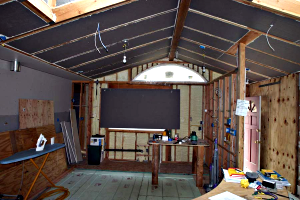 Mackey Kitchen: Foam and Rigid Insulation.
Mackey Kitchen: Foam and Rigid Insulation.
Photo credit: Daniel MackeySometimes Home Energy gets accused of being California-centric. We cover home building and renovation from all over the country and all over the world—our January/February 2009 issue will include articles about home building in Denmark and a cutting-edge green community in Italy. But since California leads the way when it comes to energy efficiency in the United States, it does get more than it's share of press. The American Council for an Energy Efficient Economy (ACEEE) just released its 2008 State Energy Efficiency Scorecard, and California ranked first in efficiency, followed by Oregon, Connecticut, Vermont, New York, and Washington. My home state, Maryland, went from 20th in 2006 to 12th in 2008. Florida went from 29th to 19th.
Since the 1970s and the first energy crisis, California's per capita energy use has remained about the same. Even though we all now have a lot more gadgets--computers, cell phones, DVD players--and a lot more air conditioning, energy use per person has remained the same. This is thanks to energy efficiency. But the world needs more than efficiency to deal with the present energy and environmental crisis. We need to use less energy overall. California, which has committed to reduce its CO2 emissions rate to 1990 levels by 2020, can't rest on its laurels.
California's Title 24 building codes are among the most progressive in the country. New homes built in California today are about 15% more energy efficient than the average new home. But 70% of California's existing housing stock was built before Title 24 came into being in 1980. Making new homes more efficient is not enough. To solve our energy and environmental problems, we have to make our existing homes much more efficient. Home Energy is publishing an article in its January/February 2009 issue about an old home outside Pittsburgh, Pennsylvania, that was retrofit to use 80% less energy than it did before the retrofit (way to go Pennsylvania!). This was done without a lot of fancy and expensive technology. The house is comfortable, and the occupants are energy conscious and make wise choices about its energy use. It gets down to the basics--air sealing, insulation, proper ventilation, and educated occupants.
A new program in California is reaching for deep energy savings in existing homes. Build It Green's GreenPoint Rated Existing Home program aims at "the mother lode of energy savings," California's existing homes (Build It Green also rates and labels new homes). "GreenPoint Rated Existing Home makes it possible for existing green homes and remodels to quantify their performance in the five key environmental categories of Community, Energy, Indoor Air Quality, Resource Efficiency, and Water, while providing the homeowner with a label they can trust," writes Cory Fitch, Program Associate for Build It Green. "The GreenPoint Rated label adds value to the home as homeowners gain confidence that their home is not only more resource efficient, but more comfortable and healthy as well." The program is past the pilot stage, and Build It Green is offering training to contractors and builders who want to participate in the program. As the housing market continues to slump, builders can distinguish themselves from the competition by offering green homes and green home retrofits and by participating in reputable labeling programs like Build It Green's. And saving energy and money makes more sense in difficult economic times.
37.8686 -122.267
